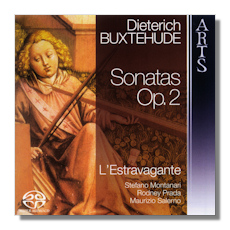
The Internet's Premier Classical Music Source
Related Links
- Buxtehude Reviews
- Latest Reviews
- More Reviews
-
By Composer
-
Collections
DVD & Blu-ray
Books
Concert Reviews
Articles/Interviews
Software
Audio
Search Amazon
Recommended Links
Site News
 SACD Review
SACD Review
Dietrich Buxtehude

Sonatas for Violin, Viola da Gamba and Cembalo, Op. 2
- Sonata I in B Flat Major, BuxWV 259
- Sonata II in D Major, BuxWV 260
- Sonata III in G minor, BuxWV 261
- Sonata IV in C minor, BuxWV 262
- Sonata V in A Major, BuxWV 263
- Sonata VI in E Major, BuxWV 264
L'Estravagante
Arts 47732-8 Hybrid Multichannel SACD 67m DDD
Danish-born Dieterich Buxtehude (1637-1707) was a prolific composer from the mid-Baroque period, but during his lifetime, the only music of his to be published was two sets of seven sonatas each, Op. 1 and Op. 2. These were scored for violin, viola da gamba, and harpsichord. At that time (1696), Buxtehude was employed as an organist at the Marienkirche in the German city of Lübeck. The first set, published at the composer's expense, was dedicated to the mayor and senators of Lübeck – his long-time employers. The second set was dedicated to "Signor Giovan Rittero" (Johann Ritter?), another city official. Possibly Buxtehude intended them for his own use, with Johann Adam Reinken and Johann Thiele. (As time goes on, we are beginning to learn more about the latter's work as a composer.)
Holed up in Lübeck (to be fair, earlier in his career he held posts in Denmark), and largely unpublished, Buxtehude nevertheless had quite a reputation among other composers of the day. Both Handel and Bach traveled to Lübeck – the latter by foot from Arnstadt, twenty miles away – to meet with him.
These sonatas do not adhere closely to any contemporary models. Generally, slow and fast movements alternate, although the number of movements varies greatly from sonata to sonata. Rarely, as in the third sonata from Op. 2, Buxtehude introduces a dance movement – in this case, a gigue. In essence, both within movements and between them, the form of these sonatas is quite free. On the other hand, counterpoint, where it is introduced, is highly developed. It is remarkable how, in the same sonata, Buxtehude can give free rein to his imagination and also compose the most disciplined counterpoint. They never sound dull.
These works received little attention during the LP era, but now we lots of choices. I believe that this is the first one in the SACD format, however. The present performers (who also recorded Op. 1) play this music with an unforced vigor, and also demonstrate an awareness of stylistic issues. True, the violin and the viola da gamba don't sound as smooth and warm as modern strings would, but I never felt like I was wearing a hair shirt as I enjoyed these well-recorded (and well-annotated) readings.
Copyright © 2008 by Raymond Tuttle




















